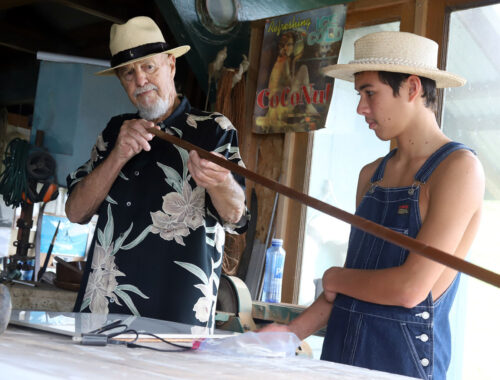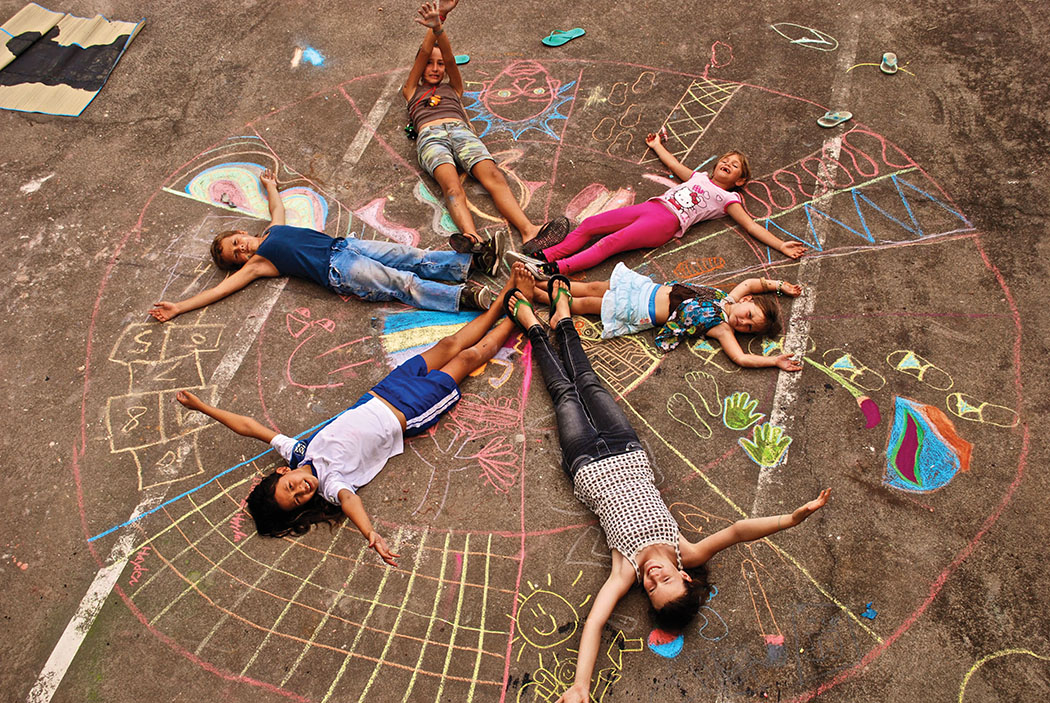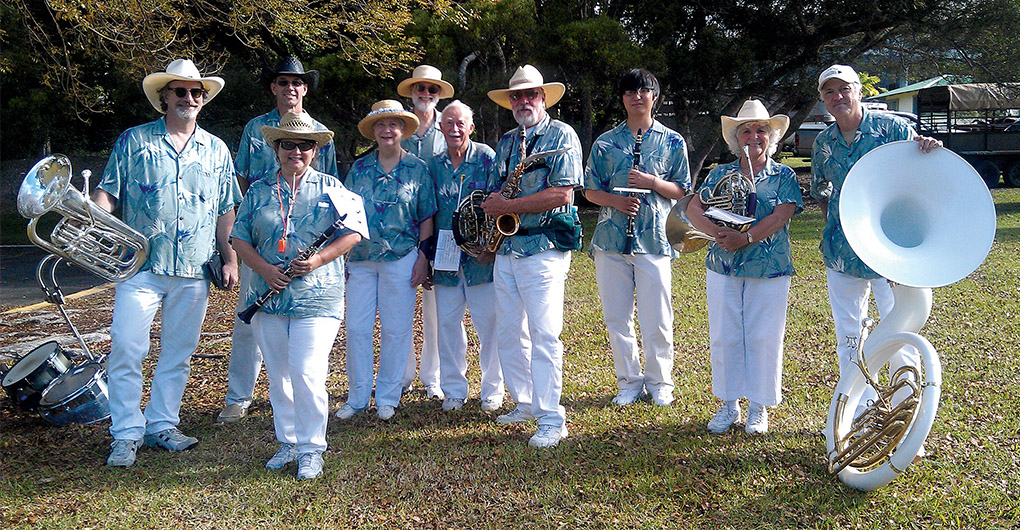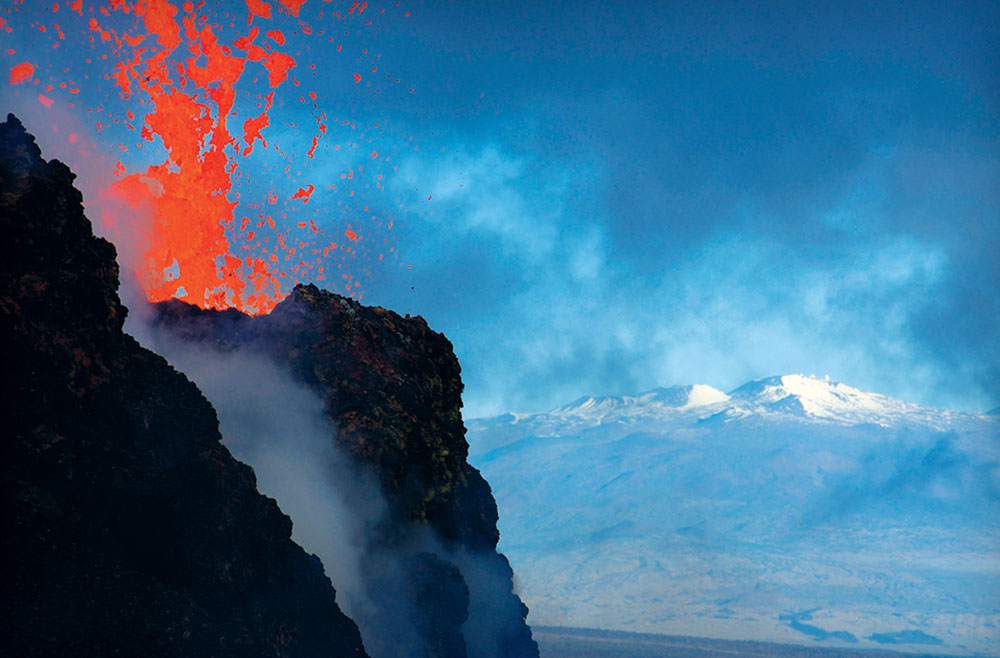
Catching Fire: The Watchful Lens of Bryan Lowry
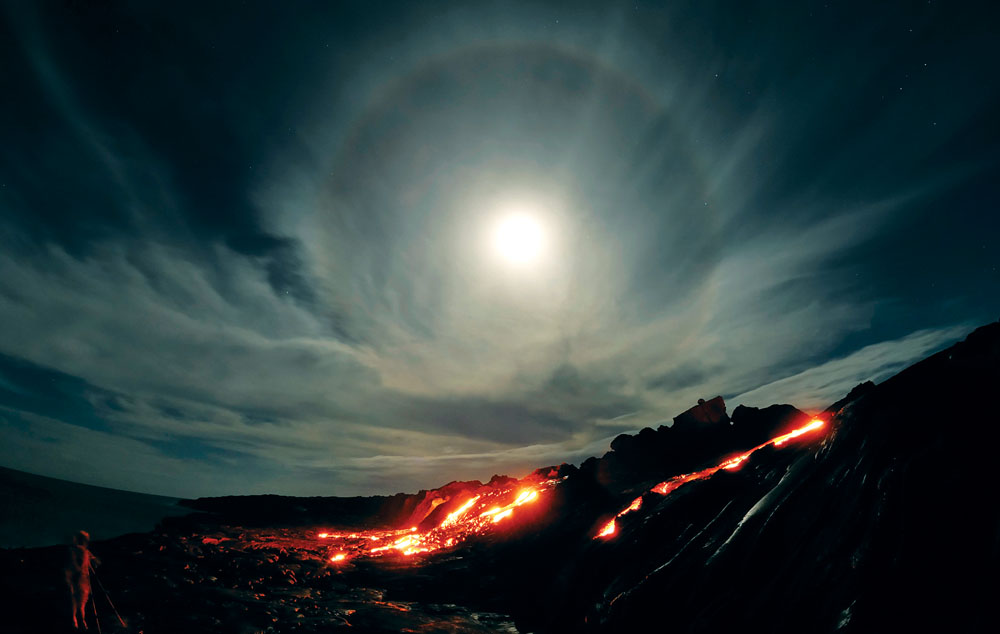
By Marya Mann
Oh play catch with the sun,
Your feet to the fire, building on the run.
Incandescence in the skies,
Captured by attentive eyes.
Bryan Lowry, watchful and calm, wedges his boots into warm fissures on the south slope of Pu‘u ‘Ō‘ō, the 800-foot cone of churning magma in the volcanic heart of Kilauea. Seven hours ago, he left his gear below and ascended the south slope, a steep wall of loose cinder, to hover near the hissing vent, shrouded in mists of sulphuric acid.
A colorful display of liquid fire leaps into the sky, spattering crimson lava in fractal patterns that blaze against the blue, Big Island sky.
Clinging to the basalt-rich lava stone below crater’s lip, the award-winning adventure photographer gazes at the bursting and blossoming of new earth, touches the air respirator around his neck and rechecks his camera settings.
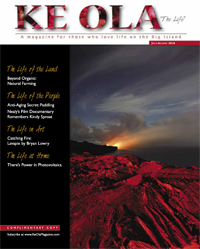
The shot he wants already has a name: Fire and Ice. He began his search 13 years before, when he stood on the snowy summit of Mauna Kea and spotted ruby tongues, lasers of fire, and sparks of gold leaping from the throat of Pu‘u ‘Ō‘ō. Sulfur clouds swerve and he’s in zero visibility, hugging the edge of the crater. Pungent vapors cloud the distant view of Hawai‘i’s regal queen, Mauna Kea. He knows the view is there, if the sky will just clear before the awesome sight of flying fire stops, or he wears out and has to try another day.
He knows the shot. He’s has aimed at it with his mind’s eye a thousand times. It must, at some point, be revealed, like Moses’ burning bush, a fountain of fire rising from the sloshing pit of magma, illuminating the sky, with the ultimate photograph: a clear shot framing the effusive Pu’u ‘Ō‘ō against the backdrop of the icy peak of the ancient mountain.
Bryan knows the subtle movements of the entire flow area from Chain of Craters road in the park to its stunning entry into the sea at Kalapana. When the action is hot, he can hike the pitted ravines and rounded “toe” shapes of cooling pahoehoe of Volcanoes National Park in the billowy dark.
He’s been known to stay awake for 65 hours, inside the craters and spillways of one of the world’s most active volcanoes, keeping his artistic vigil so close to the radiant fire his cheeks will “flashburn” in the unimaginable heat.
Stationed like a sentinel at the gates of Pele’s labor, he feels the thundering beneath his fingers, waiting for the once-in-a-lifetime moment, to capture an other-worldly scene, never before seen.
Spectacular Beauty
Extraordinary glimpses of Kilauea like Fire and Ice, captured in February of 2005, and the even more lyrical pieces like Lunar Rainbow, convey the wild, timeless spectical of our planet recreating itself, but they don’t come easily. To capture these images, Bryan has concentrated all his energies on being in, living with, absorbing, learning, and reading the subtle signals of the Pu‘u ‘Ō ‘ō-Kupaianaha eruption of Kīlauea, which began in 1983.
While geologists study the magmatic differentiation in olivine basalt flows and write papers on rock composition in the Uwekahuna laccolith, Bryan combs the crenellated crevices of ruby-fringed lava pouring from the volcano to Kalapana and the sea.
 Lava Training Area
Lava Training Area
“Safety is always first,” he says as we walk the lava flats north of Kona Airport, one of his favorite “lava training areas.” The crunch of a’—sharp chips of lava— sounds beneath our feet. “I wouldn’t have taken you where I was the past two nights. My experiences aren’t typical out there,” he says, gazing at me with intense blue eyes. He points to frozen lava plains that rigidified more than 200 years ago after pouring from Hualalai, the calm brother of Kilauea, cozy in his two-century nap—for now.
Kilauea, however, is wide awake and flexing her fertility.
He points out relics of lava pits and tumulus mounds, saying, “The smell of lava relaxes me. As he walks he avoids the “shelly pahoehoe,” the brittle lava that flows with lots of gases. “It leaves pockets, and you walk over it, it’s like going through pie crust. If it breaks through, you can get cut. And don’t walk on stuff when it’s hot.”
Lava at First Sight
“I like hiking at night. I can find my way with only two feet of flashlight in front of me. Maybe it’s the Native American in me.”
Lowry’s family stems from the Lumbee tribe in North Carolina, but he grew up in Michigan, where he picked up his first Kodak 110 Instamatic at the age of 10. Flashing his first photo, a Christmas tree, it was love at first sight.
As he matured, he started traveling, got married, moved to California, split with his wife, and made his way to Hawai‘i in 1991. At the volcano, it was lava at first sight.
“I’d always been into photography, but I didn’t get serious about it until I saw my first lava flow. Even though I moved here with nothing and knew no one, I went out to the volcano and hiked and I just knew. This is where I belong.”
He’s never had a guide, but he’s “spent a fortune on shoes,” wearing out four pairs of shoes every year for the last two decades, walking on the burning ground. “I need orthotics because one leg is shorter than the other. I can’t just go get new shoes,” he says. “They have to be melt-proof, rugged, and outfitted with costly lifts. “I need the exact same slippage on both feet, for safety.”
Does he have a special connection to Pele? “Pele shows up in my pictures sometimes. People notice. I don’t. For some, the volcano is a spiritual experience,” he says. “For me it’s a geological spectacle. I view it as a living art museum and nature is the artist. I am just lucky enough to be able to capture some of its images with my camera.”
“I’ve hiked every inch of Kilauea before eruptions. I know eruptions. I’ve stashed food and water along the routes I walk.”
He doesn’t always get his shot, because microclimates can come and go in a flash of muffled torches and subdued glows, shape-shifting his fiery mistress.
“My motto is, ‘Live to shoot another day,’” he says. “You can’t get the photo if you’re dead. I hope to learn to paint so I can show some of the visions I’ve seen but couldn’t catch with a camera.”
He now shoots digitally with a Nikon DSLR. “I don’t need to do a lot on my computer, maybe tune up and resize. When the shot is good, it doesn’t need it.”

Not in Michigan Any More
Making his way among the frigid lava “toes” at night requires high-intensity flashlights, special shoes and a cell phone with extra-long battery life to call his mother in Michigan.
His mother? Michigan?
“Yes, I trained her to read the updates on eruptions from the USGS. She gets the reports on the website, so when I’m out shooting at the crater in middle of the night, it’s daytime for her. She gives me details from geological readings of the eruptions so I can avoid too many risky situations and capture the best shots.”
Still, his intuition and long experience in feeling the flow of nature serve him best. “I haven’t missed much since the Kupaianaha to Kalapana eruption,” he says.
Through Art You Can Change a Life
“When I was born, I had two severe club feet,” says Bryan. His mother, Violet Lowry, was told, “He’ll never walk.” Dr. Corbett of the Easter Seals Society entered their lives and said, “I can fix it.”
It took seven surgeries to turn his feet around and he had six surgeries on his hands in the first 12 years of his life. He wore braces similar to Forrest Gump, even to bed.
So Lowry has developed a plan to give back to the program that brought him to his mastery. Without Easter Seals, he would not have been able to walk the thousands of miles it has taken him to know, develop and share his gift for giving eyes to the volcano.
“I have now teamed up with Easter Seals of Hawai‘i and 20 percent of all my website print sale profits go to help disabled children in Hawai‘i. I myself am a product of Easter Seals. This island is far from any large population and any and all charity help is needed for disabled children.”
Kona Mountain Coffee is also matching Bryan’s 10 percent donation of profits from retail-location sales to Easter Seals Hawai‘i, making 20 percent of every purchase of his artwork a donation to the empowering service.
Fire and Ice
The day has come. Bryan rests in the radiant warmth of Kilauea and munches on a granola bar, waiting. Everything needs to be perfect—the flow, the fire, the spewing, the weather, the snow on Mauna Kea and the incandescent visual music rising into one sublime sonata.
One moment there’s a shuddering waltz, the next a chaotic explosion, percussive shouts of a mother in labor, a steam engine spattering flames that bring a glow to the sharp lava needles beneath Bryan’s folded legs.
The lighting changes by the second, as though a knob turned. Lowry shifts his camera settings in accord with the mood of the volcano.
Around 9:30 a.m., he gets up and stretches. Abruptly, the mist lifts, like a rising stage curtain, and in that moment a set of circumstances converge into a perfect scene. The largest mountaintop on Earth, the snow-capped summit of Mauna Kea, comes into view, standing guard over his little sister, Kilauea, with her Pu’u O‘o conduit.
He must get his shot. He aims. He calmly shoots off 16 pictures, testimony to the vision he has held in his mind for most of the 20 years he has offered his eyes in service to the volcano.
He gets his shot. The moment is over.
Yet the moment lives forever in his photograph.
Start to finish: three minutes. Preparation: a lifetime. ❖
Bryan Lowry’s prints can be purchased at www.lavapix.com or at these Big Island locations:
Kona Mountain Coffee
www.konamountaincoffee.com 73-4038 Hulikoa Drive, Kailua Kona, HI 96740-2722
808.329.5005
Krazy About Kona
www.krazyaboutkona.com
75-5744 Alii Dr., Kailua Kona, HI 96740
808.329.4749
Trudy’s Island Arts
www.artandgiftshawaii.com
74-5533 Luhia Street, Kailua Kona, HI 96740-3643
808.329.7711
